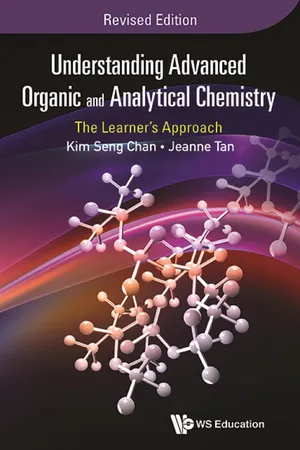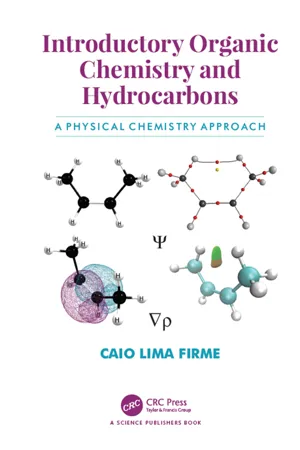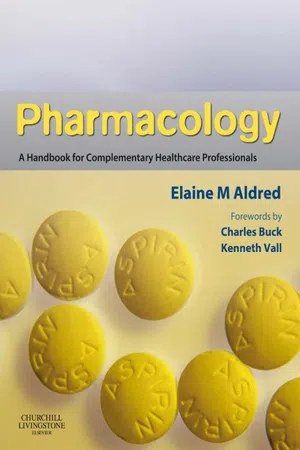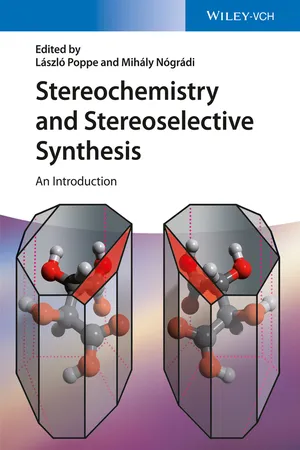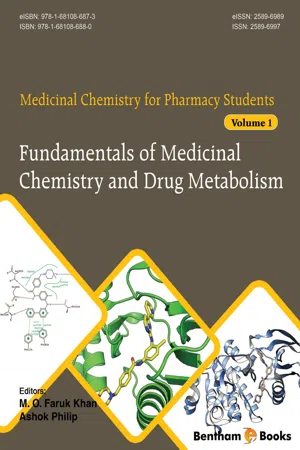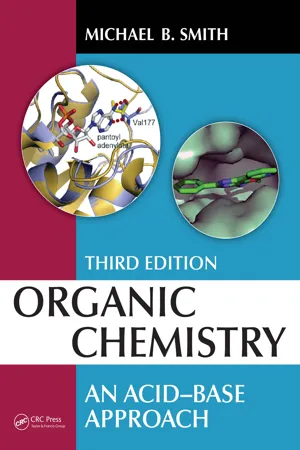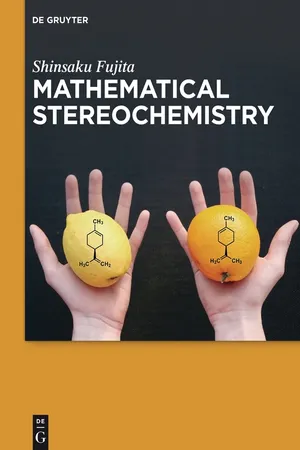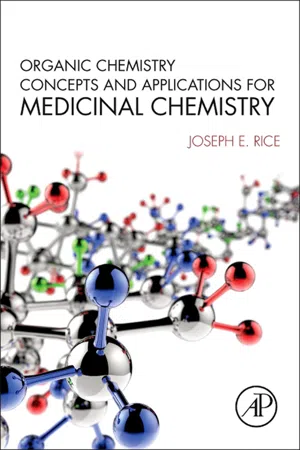Chemistry
Positional Isomers
Positional isomers are a type of structural isomer in chemistry. They have the same molecular formula but differ in the position of functional groups or substituents within the molecule. This results in different physical and chemical properties. For example, in organic compounds, changing the position of a functional group can lead to distinct reactivity or biological activity.
Written by Perlego with AI-assistance
Related key terms
Related key terms
1 of 4
Related key terms
1 of 3
12 Key excerpts on "Positional Isomers"
- eBook - ePub
Understanding Advanced Organic and Analytical Chemistry
The Learner's ApproachRevised Edition
- Kim Seng Chan, Jeanne Tan;;;(Authors)
- 2016(Publication Date)
- WS EDUCATION(Publisher)
CHAPTER 2
Isomerism in Organic Compounds
2.1 Introduction
If a molecule has the molecular formula C4 H8 , does it imply that all the C4 H8 molecules are identical? The alkene, but-1-ene, whose molecule is shown below, has the molecular formula C4 H8 .Yet, C4 H8 also represents the formula for cyclobutane, which belongs to the cycloalkane family:Compounds that have the same molecular formula but different structures are known as isomers. This phenomenon is known as isomerism. The two main types of isomerism are constitutional/ structural isomerism and stereoisomerism. These are further divided into subclasses of which some are discussed in this chapter. Isomers generally have different physical and chemical properties, but they can also have similar chemical properties if they contain the same functional groups. Each specific functional group possesses a characteristic set of chemical reactions.2.2 Constitutional/Structural Isomerism
Constitutional/structural isomers are compounds with the same molecular formula but different structures or structural formulae. Both but-1-ene and cyclobutane constitute a pair of constitutional/structural isomers. The difference in structures can be attributed to either a difference in the arrangement of atoms or due to the presence of different functional groups.Based on the above definitions, constitutional/structural isomerism can be classified into three main types:• chain isomerism;• positional isomerism; and• functional group isomerism.2.2.1 Chain Isomerism
Compounds that exhibit chain isomerism with each other have the same functional group but differ in the way the carbon atoms are connected in the mainskeletal carbon chain of their molecules. In other words, these molecules differ in the degree of branching, hence the term chain isomers - eBook - ePub
Carbohydrate Chemistry
Fundamentals and Applications
- Raimo Alén(Author)
- 2018(Publication Date)
- WSPC(Publisher)
Constitutional isomers generally differ from one another only in the order of attachment of their atoms and the location of their bonds. In the functional group isomerism, the isomers have the same molecular formula, but their functional groups are different. The following compounds are examples of such isomers:Chain isomers have the same molecular formula, but the skeleton (usually carbon skeleton) differs by having branches or otherwise. The following compounds (C5 H12 ) are examples:The number of chain isomers increases very rapidly with the increase in the number of carbon atoms in the compound. Theoretically, for 6, 7, 8, 15, and 20 carbon atoms in an aliphatic hydrocarbon, the numbers of possible chain isomers are 5, 9, 18, 4347, and 366,319, respectively.In position isomers, a functional group can be located at different points on the carbon chain, or it can be attached to a different point in the ring structure of an aromatic derivative, in which case the isomers have identical carbon chains (or aromatic ring structures). This type of isomerism is found, for example, in some alkanes, alcohols, ketones, and aromatics. The following compounds are examples of typical position isomers:3.3.Basic Factors Influencing the Three-dimensional Compound Structures
The direction of bonds. The basis of the three-dimensional structure of a molecule is the orientation in space of the bonds between its atoms. Table 3.1 contains the ground-state electron configurations of the elements that typically occur in organic compounds. When atoms form covalent bonds with each other, theiratom orbitals(expressed with orbital quantum numbers 0, 1,… or letterss,p,d,…) partially overlap. This forms commonmolecule orbitalswhere, similarly to atomic orbitals, a maximum of two electrons can occupy each molecule orbital. Only the valence electrons occupying the outermost electron shell (expressed with the principal quantum numbers 1, 2, 3,… or lettersK,L,M - eBook - ePub
Introductory Organic Chemistry and Hydrocarbons
A Physical Chemistry Approach
- Caio Lima Firme(Author)
- 2019(Publication Date)
- CRC Press(Publisher)
Chapter ThirteenIsomerism
ISOMERISM AND TYPES OF ISOMERISM
Isomerism gives rise to isomers that are molecules with the same chemical formula but different structural parameters or different spacial structures (different type of branching or different type of functional group or different position of the same functional group or different arrangement of substituents or different absolute configuration of the asymmetric atom).As for structural isomerism, there are three types: chain isomerism, position isomerism (or regioisomerism), and functional isomerism.The chain isomerism is related to the different position of the branching in its main chain. For example, butane and 2-methyl-propane are isomers (C4 H10 ); pentane, 2-methyl-butane and 2,2-dimethyl-propane are isomers (C5 H12 ); but-1-ene and 2-methyl propene are isomers (C4 H8 ) as well (see Fig. 13.1(A) ).Figure 13.1 Bond line formula of (A) chain isomers, (B) regioisomers, and (C) functional isomers.The position isomerism (or regioisomerism) is related to a different position of the substituent group or functional group in the molecule. For example, but-1-ene and but-2-ene are isomers (C4 H8 ), pentan-2-one and pentan-3-one are isomers (C5 H10 O), 2-chloro-propane and 1-chloro-propane are isomers (C3 H7 Cl), orto-dichlorobenzene and para-dichlorobenzene are isomers (C6 H4 Cl2 ) as well (see Fig. 13.1(B) ).Functional isomerism is related to different functional groups with the same molecular formula. For example, propanone and propanal are isomers (C3 H6 O), hexan-1-ene and cyclohexane (C6 H12 ) are isomers as well (see Fig. 13.1(C) ).Stereoisomerism is related to specific arrangements of substituents where two isomers are differentiated by their spacial disposition. Stereo means spacial.GEOMETRIC STEREOISOMERISM
Geometric stereoisomerm occurs in alkenes or derivatives and in substituted cycloalkanes. They generate two isomers called cis and trans or E and Z. - eBook - ePub
Pharmacology
A Handbook for Complementary Healthcare Professionals
- Elaine Mary Aldred(Author)
- 2008(Publication Date)
- Churchill Livingstone(Publisher)
Figure 6.2(i) ) occur because functional groups can branch off from the main carbon backbone. The number of carbon and hydrogen atoms remains the same but the structures are very different.Figure 6.2 The different forms of structural isomerism. (i) Chain (ii) positional (iii) mixture of chain and positional.Positional Isomerism
In Positional Isomers (Figure 6.2(ii) ) the structure of the carbon backbone remains the same but the functional groups or side chains are moved around the backbone.Combinations
It is possible to have a mixture of chain and positional isomerism (Figure 6.2(iii) ). Positional isomerism can occur around an aromatic ring (see Figure 5.3 , p. 31 ), hence the need for precise nomenclature.Stereoisomers
It is at this point that thinking in three dimensions becomes important. Stereoisomers are isomers whose components are connected around the same point, but whose arrangement in space is different.Entaniomers
Enantiomers are stereoisomers that are mirror images of each other and all thecomponents of the compound radiating from one point are different. The term forthis is chiral . The position of the compound around which this occurs is a chiral centre (see Figures 6.3 , and Figures 6.7 ). Take, for example, natural alanine, which is foundin only one isomeric form: L -alanine ( Figures 6.3 ). If alanine is produced synthetically, then both forms L and D alanine, are found. This is signifi cant when it comes togiving a patient nutritional supplementation, as the L isomer is more likely to fit intothe receptor site of an enzyme, which explains why natural products are favoured innutritional supplementation.Figure 6.3 The two isomers of alanine.• What exactly do D and L mean?
Light normally vibrates in all directions, but if put through a polarizer it will vibrate in only one direction (Figure 6.4(i) ). If another polarizer is placed at exactly 90°, no light will get through. You can test this yourself with two pairs of good-quality sunglasses. Line them up, and then turn one through 90°. The lens will appear black because no light is getting through (Figure 6.4 (ii) - eBook - ePub
Chemistry for Pharmacy Students
General, Organic and Natural Product Chemistry
- Lutfun Nahar, Professor Satyajit D. Sarker(Authors)
- 2019(Publication Date)
- Wiley(Publisher)
Louis Pasteur, a well‐known French biologist, chemist, and microbiologist, is the first stereochemist, who observed that salts of tartaric acid collected from wine production vessels could rotate plane polarized light, but that salts from other sources did not; this observation was made in 1849. Before we go into further details, let us have a look at different types of isomerism that may exist in organic molecules.3.2 ISOMERISM
Compounds with the same molecular formula but different structures are called isomers. For example, 1‐butene and 2‐butene have the same molecular formula, C4 H8 , but structurally they are different because of the different position of the double bond. There are two types of isomers: constitutional isomers and stereoisomers.3.2.1 Constitutional Isomers
When two different compounds have the same formula but different connections between atoms, they are called constitutional isomers. To determine whether two molecules are constitutional isomers, simply count the number of each atom in both molecules and see how the atoms are arranged. If both molecules possess the same count for all of the different atoms, and the atoms are arranged in different ways, the molecules will be considered as constitutional isomers. For example, ethanol and dimethylether have the same molecular formula, C2 H6 O, but they differ in the sequence of bonding. Similarly, butane and isobutane are two constitutional isomers. Constitutional isomers generally have different physical and chemical properties.3.2.2 Stereoisomers
Stereoisomers are compounds that have the same molecular formula and the same connection between atoms, but differ in the arrangement of atoms in the space, that is, in three dimensions (3D). For example, in α‐glucose and β‐glucose, the atoms are connected in the same order, but the 3D orientation of the hydroxyl group at C‐1 is different in each case. Similarly, cis‐ and trans‐cinnamic acid only differ in the three dimensional orientation of the atoms or groups.There are two major types of stereoisomers: conformational isomers and configurational isomers - eBook - ePub
Stereochemistry and Stereoselective Synthesis
An Introduction
- Mihály Nógrádi, László Poppe, József Nagy, Gábor Hornyánszky, Zoltán Boros(Authors)
- 2016(Publication Date)
- Wiley-VCH(Publisher)
isomerism, recommendations of IUPAC rules [2–4] are of not much help either. Consequently, along with explanations, occasionally we recommend definitions at variance with IUPAC recommendations.- Isomerism: relationship between isomers [2–4].
Isomer: one among compounds (or molecular entities) that have identical chemical formulas but can be isolated and exhibit different physical and/or chemical properties.[According to IUPAC recommendations [2–4], an isomer is one of the several species (or molecular entities) that have the same atomic composition (molecular formula) but different line formulae or different stereochemical formulae and hence different physical and/or chemical properties.]
We have to admit that even our proposed concept of isomerism including isolability is not completely unambiguous,11 since the criterion for isolability cannot be defined precisely. Nevertheless, our proposition is nearer to the everyday praxis of organic chemist than the IUPAC recommendations, since when taking them strictly, then labile, but chiral forms of tertiary amines, the tautomeric pair of acetaldehyde and vinyl alcohol, and further even different conformations of n-butane (e.g., its eclipsed and open conformations) should be regarded as isomers.Isomers can arise (taking into account the criterion of isolability) for multiple reasons (Figure 2.6 ). To distinguish the types of isomers different terms are given.Constitutional isomer: one among isomers, that is, molecules that have different constitutions but the same chemical (molecular) formula. In constitutional isomers, the connectedness - M. O. Faruk Khan, v Philip(Authors)
- 2018(Publication Date)
- Bentham Science Publishers(Publisher)
L -isomer, which may account for its differential absorption, protein binding and metabolism. Thus, the chirality or stereochemistry of drugs is an important factor to be considered for therapeutic agents. The following sections consider different stereochemical features of drugs. Definitions and illustrations are included to aid in understanding the different conformational and configurational aspects of drugs.Stereochemical Definitions and Illustrations
Isomers are molecules with identical molecular formulas but different structural formulas or different stereochemical formulas and hence different physical and/or chemical properties. Molecules having identical molecular formulas but different structural formulas are termed structural isomers. For example, ethanol (CH3 CH2 OH) and methyl ether (CH3 OCH3 ) are structural isomers as both have the same molecular formula (C2 H6 O), but different connectivity of atoms. Structural isomers would be expected to have very different physical/chemical characteristics (i.e. color, melting point, solubility, etc.).Stereoisomers come about from chirality or from restricted rotation such as in a ring or olefinic (double) bond. There are two obsolete terms that have been used in the past with respect to stereoisomers. The first, optical isomers, is used to describe stereoisomers with different optical properties. These optical properties arise from chirality and will be discussed under that topic. The second, geometric isomers, is used to describe cis-trans isomerism.Chirality is a geometric property whereby a molecule (or any rigid object for that matter) is not superimposable on its mirror image. Chirality arises either from chiral centers or from restricted rotation, referred to as axial chirality. Stereoisomers have identical molecular and structural formulas but they have different spatial arrangements of the same groups. Physical or chemical characteristics of steroisomers are usually different (except see enantiomers).- eBook - ePub
Organic Chemistry
An Acid-Base Approach
- Michael B. Smith(Author)
- 2022(Publication Date)
- CRC Press(Publisher)
Chirality, Enantiomers, and DiastereomersDOI: 10.1201/9781003174929-9The video clips for this chapter are available at: https://routledgetextbooks.com/textbooks/9780367768706/chapter-9.phpThis chapter will focus on a class of isomers that differ only in the spatial arrangement of attached atoms and groups about an atom. When two different molecules have the same atoms, groups, and the same empirical formula, they are isomers. When they have the same points of attachment (the same connectivity), but differ in the spatial arrangement of those groups, they are different molecules known as stereoisomers .To begin this chapter, you should know the following points:- Name organic molecules, based on the nomenclature rules (Sections 4.4,5 and 5.1–5.6).
- The VSEPR model for drawing structures (Section 3.6).
- σ-bonds. (Sections 3.3 and 3.8).
- π-Bonds. (Sections 5.1–5.3).
- Constitutional isomers (Sections 4.2 and 4.4).
- Rotation about covalent single bonds (Section 8.1).
- Conformations of acyclic molecules (Sections 8.1–8.3).
- Conformations of cyclic molecules (Sections 8.5–8.7).
- Physical properties associated with organic compounds (Section 5.8).
9.1 Stereogenic Carbons and Stereoisomers
Defining a Stereogenic CenterA mirror image is defined as an image or object that is identical except that the structure is reversed. A “W” and its mirror image are shown and it is easy to see that one “W” can be placed on the mirror image “W” so they are completely superimposable . In other words, the two images represent one “W,” not two.Since the “W” is symmetrical there is a plane of symmetry as shown. When a sp3 -hybridized carbon has four identical atoms or groups attached the mirror image of that molecule is superimposable. Such a molecule has symmetry and if it is superimposable, it is the same molecule. An example is methane. There is a plane of symmetry that bisects the central carbon and two of the hydrogen atoms, illustrated by the pane through the tetrahedron superimposed on methane in Figure 9.1 - eBook - ePub
Symmetry, Spectroscopy, and Crystallography
The Structural Nexus
- Robert Glaser(Author)
- 2015(Publication Date)
- Wiley-VCH(Publisher)
Chapter 5 Chiroptical Properties5.1 The Language of Symmetry, Isomerism, and the Characterization of Symmetry Relationships within and between Molecules
At the beginning of this section, it is useful to review some basic terminology in light of the fact that Mislow [63] (the author's stereochemistry mentor) has reorganized the concept of isomerism based on the principles of isometric/anisometric molecular geometry, superimposition, and constitution (atomic connectivity). The advantage of this reorganization is its ability to predict the conditions where one may experimentally differentiate between pairs of isomers. Molecules with the same chemical formulae (i.e., molecular formula: number and types of atoms) are isomers (equal units) and those that are not are heteromers (different units). All the physical and chemical properties of heteromeric pairs must be different since they are obviously not symmetry equivalent. Isomers are either isometric or anisometric. Isometric isomers have the same distance matrix and are either superimposable upon themselves (i.e., homomers, a congruent pair) or not (enantiomers). All the physical and chemical properties of an isometric pair of molecules are identical providing that the properties depend only upon the first and second dimensions. Anisometric isomers have different distance matrices but may have either the same constitution (diastereomers) or not (constitutional isomers). It is noted that diastereomer is a structure that differs from another “across”-“space”-“unit” molecule. It is derived from the Latin prefix dia meaning “across” (as in diagonios – “diagonal,” i.e., “across the angle” since gonia means “angle,” as in pentagon – a figure with five angles), stereo “space,” and mer “unit.”Isometric isomers are symmetry equivalent (homomeric pairs by operations of the First Kind and enantiomeric pairs by operations of the Second Kind). The logic of placing homomers and enantiomers within the same isometric subfamily is that the corresponding properties of a pair of homomers are identical under all measurement conditions, while only the corresponding properties of a pair of enantiomers that do not depend on the third dimension are also identical (e.g., melting and boiling points, IR, and nuclear magnetic resonance (NMR) spectrum are the same). Enantiomers may be differentiated only by measurements that probe chirality. Examples of chiral probes are metabolism by enzymes, chiral chromatography, and chiroptical measurements. - eBook - ePub
- Shinsaku Fujita(Author)
- 2015(Publication Date)
- De Gruyter(Publisher)
2.9) is successfully linked to the present 3D-based definition of a stereoisomeric relationship (Def. 2.5). Thereby, the dual nature (Table 1.1) is avoided rationally. Note that such an equivalence class of stereoisomers is based on 3D structures, where both Def. 2.5 (a stereoisomeric relationship) and Def. 2.6 (an isomeric relationship) are based on 3D structures. Exercise 2.2. – Confirm Theorem 2.1 by using a set of stereoisomers shown in Fig. 2.1 (2-1, 2-2, 2-3, and 2-3). See Eq. 2.6. – Confirm Theorem 2.1 by using the butanols listed in Fig. 1.5 on page 7 (1-16, 1-17, 1-18, and 1-19). See Eq. 2.5. 2.1.4 Isoskeletomers as a Missing Link for Consistent Terminology As discussed in Subsection 1.2.3, ‘Positional Isomers’ are regarded as a kind of constitutional isomers (Def. 2.9). This means that the term ‘Positional Isomers’ expresses a 2D-based concept. To avoid the dual features summarized in Table 1.1 and to develop consistent terminology, the 2D-based term ‘Positional Isomers’ should be replaced by a more promising term of 3D basis. A hint for carrying out the mission described in the preceding paragraph is hidden in the history of organic structural chemistry [3,4]. Kekule [ 5 ] discussed the usage of ‘rational formulas’, which correspond to C2H5OH, C2H5NH2, etc. in the modern mode of representations. These ‘rational formulas’ represent types of compounds, where C2H5OH stems from the linkage between a unit C2H5 and another unit OH. Thus, the rational formulas originally aimed at the taxonomy of organic compounds, which has been later accomplished by more informative formulas, i.e., 2D-structural formulas, although they are still used under the name condensed structural formulas. Now, the taxonomy of organic compounds is represented by linking 2D-structural formulas with compound types (e.g., alkanols and alkylamines), where the linkage has overwhelmed the usage of rational formulas - eBook - ePub
- Robert J. Ouellette, J. David Rawn(Authors)
- 2015(Publication Date)
- Elsevier(Publisher)
6Stereochemistry
6.1 Configuration of Molecules
In Chapters 3 and 4 we considered the structures of geometric isomers, which are one of a general class of stereoisomers. Stereoisomers have the same connectivity—the same sequence of bonded atoms—but different arrangements of the atoms in space. The different three-dimensional arrangements of atoms in space determine their configurations. Geometric isomers have different configurations. The configuration of a molecule plays a major role in its biological properties. Stereoisomers often have entirely different biological properties. Geometric isomers invariably elicit different responses in organisms. For example, bombykol, the sex attractant of the male silk-worm moth, has a (Z)/(E) arrangement about the double bonds at C-10 and C-12. It is 109 to 1013 times more potent than the other three possible geometric isomers. Disparlure, the sex attractant of the female gypsy moth, is biologically active only if the alkyl groups bonded to the three-membered ring are in a cis configuration.Geometric isomerism is only one type of stereoisomerism. Another type of stereoisomerism is the result of the minor image relationships between molecules, the subject of this chapter. These molecules differ in configuration about an sp3 -hybridized, “tetrahedral carbon” atom bearing four different groups of atoms, which is called a stereogenic center. This phenomenon is not as easily visualized as geometric isomers, but its consequences are even more vital to life processes.6.2 Mirror Images and Chirality
The fact that we live in a three-dimensional world has important personal consequences. In the simple act of looking into a mirror, you see someone who does not actually exist—namely, your mirror image. Every object has a mirror image, but this reflected image need not be identical to the actual object. Let’s consider a few common three-dimensional objects. A simple wooden chair looks exactly like its mirror image (Figure 6.1 ). When an object and its mirror image exactly match, we say that they are superimposable. - Joseph E. Rice(Author)
- 2014(Publication Date)
- Academic Press(Publisher)
Isomers are broken down into two broad categories. The first is constitutional isomers —compounds that differ in constitution or make-up. Thus cyclopropane and propylene (Figure 2.1) are constitutional isomers because cyclopropane is composed of three CH 2 (methylene) groups arranged into a three-membered ring, whereas propylene is acyclic with a vinyl and a methyl group. The alcohols n -propanol and i -propanol are also constitutional isomers that are similar chemically but differ in the position to which the hydroxyl group is attached (also called Positional Isomers). Thus n -propanol has the hydroxyl group attached to methylene with an ethyl group attached to the same carbon. In contrast, i -propanol has the OH group attached to a CH (methine) that is also attached to two methyl groups. Another example of this is seen with isobutylene and cis - or trans -2-butene. Isobutylene has one sp 2 -hybridized carbon with two methyl groups and another one with two hydrogen atoms attached, whereas cis - and trans -2-butene have two sp 2 carbons each with one methyl group and one hydrogen atom. Thus, isobutylene and cis - or trans -2-butene are constitutional isomers. But what is the relationship between cis - and trans -2-butene? Since they have the same constitution but differ in the special arrangement of the various groups, they are called stereoisomers. Figure 2.1 Examples of various types of isomers. Stereoisomerism at Saturated Centers In the preceding figure, cis - and trans -2-butene were shown to be stereoisomers by virtue of the spatial arrangement of groups around the double bonds. Stereoisomerism, however, can also occur at saturated centers. An example is illustrated in Figure 2.2. Structure A on the left has a carbon that is attached to H, OH, CH 2 OH, and CHO. As drawn, the central carbon, CHO, and CH 2 OH groups are in the plane of the paper, the H is behind the plane (depicted using a hashed wedge), and the OH is in front of the plane (solid wedge)
Index pages curate the most relevant extracts from our library of academic textbooks. They’ve been created using an in-house natural language model (NLM), each adding context and meaning to key research topics.
Explore more topic indexes
Explore more topic indexes
1 of 6
Explore more topic indexes
1 of 4
